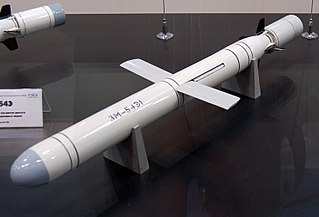 W
WThe 3M-54 Kalibr,, also referred to it as 3M54-1 Kalibr, 3M14 Biryuza, , 91R1, 91RT2 is a group of Russian surface ship-, submarine-launched and airborne anti-ship and coastal anti ship (AShM), land attack cruise missiles (LACM) and anti-submarine missiles developed by the Novator Design Bureau (OKB-8). Derived export versions are the 3M54E, 3M54E1, 3M14E, 91RE1, 91RTE2. The 3M54T, 3M54K, 3M54A, 3M54E (3M54TE), 3M54KE and 3M54AE have a second stage that performs a supersonic sprint in the terminal approach to the target, reducing the time that target's defense systems have to react. The 3M54T1, 3M54K1, 3M54A1, 3M54E1 (3M54T/K/AE1) only travel at subsonic speeds, although their range is accordingly greater than those of the supersonic versions.
 W
WThe 9M730 Burevestnik is a Russian experimental nuclear-powered, nuclear-armed cruise missile under development for the Russian Armed Forces. The missile is claimed to have virtually unlimited range.
 W
WThe Ababil-100 or al-Fat'h or al-Fatah was an Iraqi single stage solid propelled Short-range ballistic missile whose development project started around August 1991 and was tested from 2000 to 2002. It was derived from the Ababil-50 MLRS.
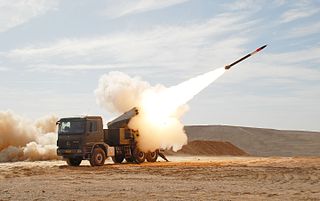 W
WACCULAR is family of artillery rockets developed and manufactured by Israel Military Industries (IMI) and used by Israel Defense Forces and international customers. It features 2 different calibers with a maximum range of 40km with a 20-35kg unitary penetration or controlled fragmentation warhead and accuracy of 10m CEP.
 W
WAl-Samoud was a liquid-propellant rocket tactical ballistic missile developed by Iraq in the years between the Gulf War and the 2003 Invasion of Iraq. The Iraqi army also developed a solid-fuel rocket version known as Ababil-100.
 W
WALAS is a Serbian long-range multipurpose wire guided missile system developed by the private company EdePro, which operates under the direction of the state-owned Yugoimport SDPR. The ALAS missile system was developed primarily for missions against tanks, armored vehicles, fortifications, command posts, low-flying helicopters, coastal ships, industrial facilities and bridges. It can be deployed by any suitable platform including helicopters, armored vehicles, small ships and infantry. The guidance system is based on video/infrared technology, with the missile connected to the launcher by a fiber-optic cable. The ALAS flies at low altitude and has small radar and infrared (heat) signatures due to using a turbofan motor instead of a turbojet. In recent years, the ALAS platform has found a secondary use as a UAV.
 W
WBina is an Iranian laser guided dual-capability surface-to-surface and air-to-surface missile.
 W
WThe EXTRA EXTended Range Artillery is an artillery rocket system developed and manufactured by Israel Military Industries IMI and used by Israel Defense Forces, Azerbaijan and Vietnam since 2013. It has a maximum range of 150km with a 120kg unitary warhead and accuracy of 10m CEP.
 W
WThe Ghadr-110 is a medium-range ballistic missile designed and developed by Iran. The missile has a range of 1,800 km to 2,000 km. The Iranian Armed Forces first displayed the missile to the public at an annual military parade to mark the Iran–Iraq War.
 W
WHermes is a family of modularly-designed guided missiles developed in Russia by the KBP Instrument Design Bureau. Capable of being fired from aerial (Hermes-A), land based (Hermes) and naval (Hermes-K) platforms, the Hermes system features a multistage rocket missile with a high-powered booster, and fire-and-forget capability with laser guidance and infrared homing. It is designed to engage single and multiple targets with single or volley fire at ranges of up to 100 km and can track and destroy over-the-horizon targets.
 W
WThe Khorramshahr, named after the city of Khorramshahr in Iran, is a medium-range ballistic missile that was tested by Iran in January 2017. Its range is between 1,000–2000 km with a 1,800 kg warhead and is 13 m in length.
 W
WThe Hatf IX or Nasr, is a solid fueled tactical ballistic missile system developed by National Development Complex (NDC) of Pakistan.
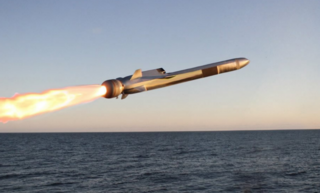 W
WThe Naval Strike Missile (NSM) is an anti-ship and land-attack missile developed by the Norwegian company Kongsberg Defence & Aerospace (KDA).
 W
WThe P-15 Termit is an anti-ship missile developed by the Soviet Union's Raduga design bureau in the 1950s. Its GRAU designation was 4K40, its NATO reporting name was Styx or SS-N-2. China acquired the design in 1958 and created at least four versions: the CSS-N-1 Scrubbrush and CSS-N-2 versions were developed for ship-launched operation, while the CSS-C-2 Silkworm and CSS-C-3 Seersucker were used for coastal defence. Other names for this basic type of missile include: HY-1, SY-1, and FL-1 Flying Dragon. North Korean local produced KN-1 or KN-01, derived from both Silkworm variants and Russian & USSR P-15, Rubezh, P-20 P-22.
 W
WThe P-120 Malakhit is a Russian medium range anti-ship missile used by corvettes and submarines. Introduced in 1972, it remains in service but has been superseded by the P-270 Moskit.
 W
WThe P-270 Moskit is a Soviet supersonic ramjet powered anti-ship cruise missile. Its GRAU designation is 3M80, air launched variant is the Kh-41 and its NATO reporting name is SS-N-22 Sunburn. The missile system was designed by the Raduga Design Bureau during the 1970s as a follow up to the P-120 Malakhit. The Moskit was originally designed to be ship-launched, but variants have been adapted to be launched from land, underwater (submarines) and air, as well as on the Lun-class ekranoplan. The missile can carry conventional and nuclear warheads. The exact classification of the missile is unknown, with varying types reported. This uncertainty is due to the secrecy surrounding an active military weapon. The missile has been purchased and exported to the People's Liberation Army Navy (China) and Indian Navy (India).
 W
WThe P-800 Oniks, also known in export markets as Yakhont, is a Soviet / Russian supersonic anti-ship cruise missile developed by NPO Mashinostroyeniya as a ramjet version of P-80 Zubr. Its GRAU designation is 3M55, the air launched Kh-61 variant also exists. The missile has the NATO codename SS-N-26 "Strobile". Development officially started in 1983, and in the 1990s the anti-ship missile was tested on the Project 1234.7 ship. In 2002 the missile passed the whole range of trials and was commissioned. It is reportedly a replacement of the P-270 Moskit, but possibly also of the P-700 Granit. The P-800 was used as the basis for the joint Russian-Indian supersonic missile BrahMos.
 W
WThe Polyphem was a proposed light-weight fibre-optic wire-guided surface-to-surface missile with a range of 60 km.
 W
WThe RBS-15 is a long-range fire-and-forget surface-to-surface and air-to-surface anti-ship missile. The later version Mk. III has the ability to attack land targets as well. The missile was developed by the Swedish company Saab Bofors Dynamics.
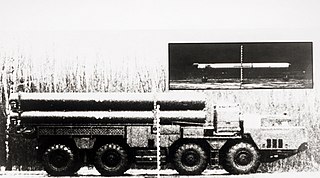 W
WThe Novator RK-55 Relief is a Russian land-based and submarine-launched cruise missile with a nuclear warhead developed in the Soviet Union. It was about to enter service in 1987, when such weapons were banned under the Intermediate-Range Nuclear Forces Treaty. A version launched from submarine torpedo tubes, the S-10 Granat, has apparently been converted to carry conventional warheads and continues in service to this day. The Russian Federation was reported to have deployed the derivative SS-CX-7/SS-CX-8 systems on February 14, 2017.
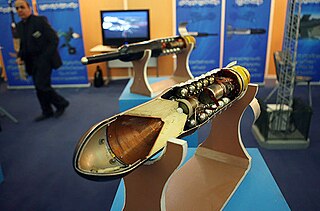 W
WThe Saegheh refers to at least six completely separate Iranian weapons systems: a RPG warhead, an anti-tank guided missile family, a surface-to-surface rocket, a target drone family, an air-to-air missile and a claimed stealth Unmanned aerial vehicle.
 W
WThe Shahab-3 is a quad-exhaust liquid-propelled medium-range ballistic missile (MRBM) developed by Iran and based on the North Korean Nodong-1. The Shahab-3 has a range of 1,000 kilometres (620 mi); a MRBM variant can now reach 2,000 kilometres (1,200 mi). It was tested from 1998 to 2003 and added to the military arsenal on 7 July 2003, with an official unveiling by Ayatollah Khamenei on July 20. With an accuracy of 140 m CEP, the Shahab-3 missile is primarily effective against large, soft targets. Given the Shahab-3’s payload capacity, it would likely be capable of delivering nuclear warheads. According to the IAEA, Iran in the early 2000s may have explored various fuzing, arming and firing systems to make the Shahab-3 more capable of reliably delivering a nuclear warhead.
 W
WThe Shaurya missile is a canister launched hypersonic surface-to-surface tactical missile developed by the Indian Defence Research and Development Organisation (DRDO) for use by the Indian Armed Forces. It has a range of 700 to 1,900 km and is capable of carrying a payload of 200 kg to 1 tonne conventional or nuclear warhead. It gives the potential to strike at very-long-range against any adversary.
 W
WThe P-5 "Pyatyorka", also known by the NATO codename SS-N-3C Shaddock, is a Cold War era turbojet-powered cruise missile of the Soviet Union, designed by the Chelomey design bureau. The missile entered service in 1959. Pyatyorka is a common name for the missile as the "digit 5", corresponding to the R-7 Semyorka, the digit 7.
 W
WThe SSM-700K Haeseong (C-Star) Anti-ship Missile is a ship launched sea-skimming surface-to-surface anti-ship cruise missile developed by the South Korean Agency for Defense Development (ADD), LIG Nex1 and the Republic of Korea Navy in 2003. The missiles are deployed on KDX-II and KDX-III destroyers as of 2006, each carrying 8 and 16 of the missiles respectively, and on Ulsan-class frigates.
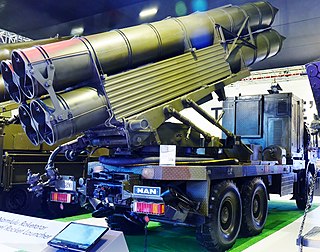 W
WThe TRG-300 Tiger is a Turkish multiple launch rocket system manufactured by the ROKETSAN corporation. The system has four 300 mm rocket launcher tubes and its rockets can hit a maximum range of 120 km.
 W
WThe Weishi family of multiple rocket launcher systems were mainly developed by Sichuan Aerospace Industry Corporation in Chengdu, China. The systems include the 302 mm (11.9 in) WS-1, the improved 302 mm (11.9 in) WS-1B, the 122 mm (4.8 in) WS-1E, the 400 mm (16 in) WS-2, as well as many other models. The WS-1 series weapon system did not enter PLA service and has order from Thailand. The WS-2 may finally see PLA service in the future. It's worth noticing that although sharing the same name, there are other developers for different models of Weishi series multiple rocket launchers (MRL) other than the primary developer SCAIC.